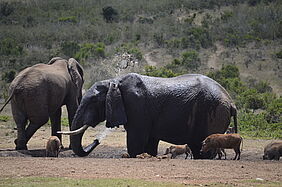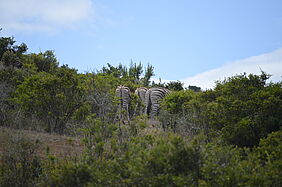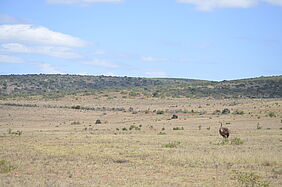When I was thinking about how to start this blog entry I was always thinking about something like this:
Leaves crinkling. It cracks in the bush somewhere. Something is moving. Something big.
The problem is: Nothing cracked. Nothing crinkled. And still there was an elephant walking right beside the car. Slow, majestic and he did not care at all about clicking cameras and four stunned, german girls watching him.
This happened in the Addo Nationalpark just about an hour away from PE. Addo is the third largest national park in South Africa, after Kgalagadi Transfrontier Nationalpark and Kruger Nationalpark. The history of Addo is rather tragic. In the 18th and 19th century farmers and elephants competed for land and water. The farmers kept extending their land which forced the elephants to either move away or look for food and water on the farmlands. To stop them from destroying the fields more and more elephants were killed. The „fight“ between human and elephant reached its peak in 1919 when the government followed a request from the farmers and hired an elephant hunter. In only two years this guy killed more than one hundred elephants in the Addo region. In 1931 only eleven elephants were left. To protect these eleven individuals Addo Nationalpark was founded. Since then it kept growing from the original 2000 hectare to about 686 000 hectare nowadays. The population of the elephants grew in the same rapid speed to about 600 individuals. These are actually too many for nature so the Nationalpark is trying to lower the birth rate (e.g. long walking distances between water holes, etc.).
But enough about history and back to our present. We booked the half-day tour starting at nine in the morning which meant: getting up at six to leave at seven. Not our best idea after a night-out in the township… Anyway, we were greeted by nice people, had a nice cup of tea on an even nicer veranda overlooking Sundays River. And once we were in the car and saw the first (and only) monkeys all our tiredness was gone.
Following the dusty gravel road scattered with elephant droppings we started our mini-adventure. First highlight: the famous, flightless dung beetle. And yes, Addo is as well known for this little guy as it is for the grey giants. They preferably roll the elephant dung on the road, therefore there are signs everywhere to remind people to „give way“ to the beetles.
We went deeper and deeper into the Addo. A feeling of wilderness did not come up though. Too many cars, vans and tour vehicles were around, especially at the waterholes. The animals did not stress about all the fuss around (and about) them. Antelopes were resting in the shade, watching the vehicles like we watch TV. Zebras were minding there own business only showing us their striped butts. Elephants were bathing not giving a heck about the twenty cars around the water hole. A hyena was just sleeping right next to the road, not even moving one paw when we stopped next to her.
But the winners of our hearts were definitely the warthogs. These little creatures that look and move like they are coming straight out of a comic book just won all our sympathy. And even at the end after all the dozens of warthogs we still pointed them out and were delighted by their presence.



